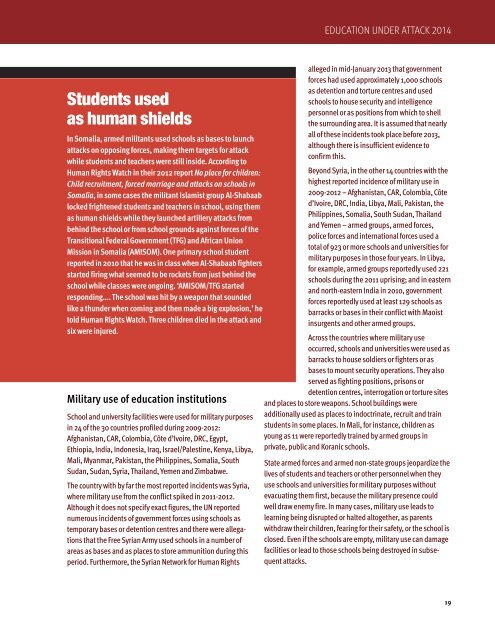You also want an ePaper? Increase the reach of your titles
YUMPU automatically turns print PDFs into web optimized ePapers that Google loves.
EDUCATION UNDER ATTACK 2014<br />
Students used<br />
as human shields<br />
In Somalia, armed militants used schools as bases to launch<br />
attacks on opposing forces, making them targets for attack<br />
while students and teachers were still inside. According to<br />
Human Rights Watch in their 2012 report No place for children:<br />
Child recruitment, forced marriage and attacks on schools in<br />
Somalia, in some cases the militant Islamist group Al-Shabaab<br />
locked frightened students and teachers in school, using them<br />
as human shields while they launched artillery attacks from<br />
behind the school or from school grounds against forces of the<br />
Transitional Federal Government (TFG) and African Union<br />
Mission in Somalia (AMISOM). One primary school student<br />
reported in 2010 that he was in class when Al-Shabaab fighters<br />
started firing what seemed to be rockets from just behind the<br />
school while classes were ongoing. ‘AMISOM/TFG started<br />
responding…. The school was hit by a weapon that sounded<br />
like a thunder when coming and then made a big explosion,’ he<br />
told Human Rights Watch. Three children died in the attack and<br />
six were injured.<br />
Military use of education institutions<br />
School and university facilities were used for military purposes<br />
in 24 of the 30 countries profiled during 2009-2012:<br />
Afghanistan, CAR, Colombia, Côte d’Ivoire, DRC, Egypt,<br />
Ethiopia, India, Indonesia, Iraq, Israel/Palestine, Kenya, Libya,<br />
Mali, Myanmar, Pakistan, the Philippines, Somalia, South<br />
Sudan, Sudan, Syria, Thailand, Yemen and Zimbabwe.<br />
The country with by far the most reported incidents was Syria,<br />
where military use from the conflict spiked in 2011-2012.<br />
Although it does not specify exact figures, the UN reported<br />
numerous incidents of government forces using schools as<br />
temporary bases or detention centres and there were allegations<br />
that the Free Syrian Army used schools in a number of<br />
areas as bases and as places to store ammunition during this<br />
period. Furthermore, the Syrian Network for Human Rights<br />
alleged in mid-January 2013 that government<br />
forces had used approximately 1,000 schools<br />
as detention and torture centres and used<br />
schools to house security and intelligence<br />
personnel or as positions from which to shell<br />
the surrounding area. It is assumed that nearly<br />
all of these incidents took place before 2013,<br />
although there is insufficient evidence to<br />
confirm this.<br />
Beyond Syria, in the other 14 countries with the<br />
highest reported incidence of military use in<br />
2009-2012 – Afghanistan, CAR, Colombia, Côte<br />
d’Ivoire, DRC, India, Libya, Mali, Pakistan, the<br />
Philippines, Somalia, South Sudan, Thailand<br />
and Yemen – armed groups, armed forces,<br />
police forces and international forces used a<br />
total of 923 or more schools and universities for<br />
military purposes in those four years. In Libya,<br />
for example, armed groups reportedly used 221<br />
schools during the 2011 uprising; and in eastern<br />
and north-eastern India in 2010, government<br />
forces reportedly used at least 129 schools as<br />
barracks or bases in their conflict with Maoist<br />
insurgents and other armed groups.<br />
Across the countries where military use<br />
occurred, schools and universities were used as<br />
barracks to house soldiers or fighters or as<br />
bases to mount security operations. They also<br />
served as fighting positions, prisons or<br />
detention centres, interrogation or torture sites<br />
and places to store weapons. School buildings were<br />
additionally used as places to indoctrinate, recruit and train<br />
students in some places. In Mali, for instance, children as<br />
young as 11 were reportedly trained by armed groups in<br />
private, public and Koranic schools.<br />
State armed forces and armed non-state groups jeopardize the<br />
lives of students and teachers or other personnel when they<br />
use schools and universities for military purposes without<br />
evacuating them first, because the military presence could<br />
well draw enemy fire. In many cases, military use leads to<br />
learning being disrupted or halted altogether, as parents<br />
withdraw their children, fearing for their safety, or the school is<br />
closed. Even if the schools are empty, military use can damage<br />
facilities or lead to those schools being destroyed in subsequent<br />
attacks.<br />
19


